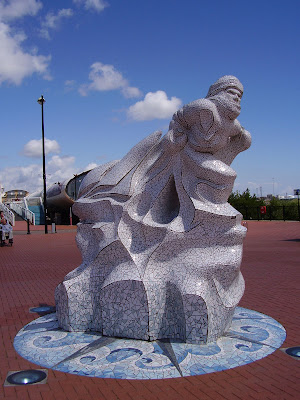 (Click photos to enlarge).
(Click photos to enlarge).When I composed the by-line for this blog - "Ancient and not-so-ancient places of interest that I have visited in the UK" - I freely admit that I kept it deliberately vague, for although I have a bias for neolithic sites, standing stones, dolmens, stone cirles, etc, I also wanted to feature some more modern places (relatively speaking) too. For instance, there are a number of fascinating churches all over the country.
One of my very favourite churches - the white-painted wooden structure of the Norwegian Church in Cardiff - dates to the 19th Century which makes it very modern indeed when compared with the subjects I've featured thus far, but it is a building that I have a great fondness for. The Church is located by the waterside in Cardiff Bay, and is a near neighbour to the Welsh Assembly in an area of Cardiff that has featured in BBC Wales' science fiction show Torchwood as well as several episodes of Doctor Who. Look closely in some of the Torchwood episodes and you may even spot the Norwegian Church.
 Today the Norwegian Church functions as an arts centre and has a very nice cafe downstairs - a great place to grab a coffee and a slice of cake. To give a little history, I'll quote from the church's website:
Today the Norwegian Church functions as an arts centre and has a very nice cafe downstairs - a great place to grab a coffee and a slice of cake. To give a little history, I'll quote from the church's website:"The Port of Cardiff was one of the first to have a Norwegian Sailor’s Church established to provide religious and social care to thousands of Norwegian sailors that were employed in the Norwegian merchant fleet. The Church was founded by Herman Lunde of Oslo and built in 1868 between the East and West Docks on land that was donated by the Marquis of Bute. It was consecrated in the December of that year. In the years that followed, the Church was extended a number of times when the reading rooms were enlarged. In 1885 the most significant alterations took place when a gallery and a bell tower were added."Read more at: www.norwegianchurchcardiff.co.uk
The author Roald Dahl, who was born in Cardiff to Norwegian parents, was christened at the Norwegian Church (as were his sisters). Shortly before his death in 1990 he became the president of the Norwegian Church Preservation Trust, an organisation that sought to restore the church after it had fallen into dereliction.
 Curiously juxtaposed within a few metres of the Norwegian Church is a memorial statue to Captain Scott. Scott and his party, of course, were beaten to the South Pole in January 1912 by a Norwegian party led by Roald Amundsen. It was on their return journey from this expedition that Scott and his comrades perished.
Curiously juxtaposed within a few metres of the Norwegian Church is a memorial statue to Captain Scott. Scott and his party, of course, were beaten to the South Pole in January 1912 by a Norwegian party led by Roald Amundsen. It was on their return journey from this expedition that Scott and his comrades perished.UPDATE: With referernce to the Captain Scott memorial , my father adds that: "The reason for its location is, of course, that is where they set out from for the Antarctic. The curious coincidence is that they were beaten to the South Pole by a Norwegian. There is another memorial to Capt Scott in Cardiff – the 'lighthouse' in Roath Park lake on top of which sits a model of the Terra Nova."
(Pictures of the Captain Scott 'Lighthouse' memorial in Roath Park Lake can be seen here).
Date visited: 19 June 2008






Bloody Vikings!
ReplyDeleteBloody Yank! :oP
ReplyDelete